Flashing

Flashing, and why it is essential to your roof!
Roof flashing is a thin material, usually galvanized steel, that professional roofers use to direct water away from critical areas of the roof, wherever the roof plane meets a vertical surface like a wall or a dormer. Flashing is installed to surround roof features, such as vents, chimneys and skylights. Water should run down the side of the flashing and be directed to the shingles instead of finding its way into the roof deck.
Continuous flashing: Continuous flashing is also called “apron flashing” because it acts a lot like an apron. It’s a long, single piece of metal that carries water down to the shingles below. Long pieces of continuous flashing will have trouble flexing as the home expands and contracts in the changing seasons. If left as is, it could break or warp and fail to keep water out. Therefore, long pieces have built-in expansion joints so they can move with the home.
Base flashing: Some roof features, such as chimneys, require two pieces of flashing. This ensures that rain always meets a flashing surface that directs it downwards. Plus, it is notoriously tough to install flashing around a chimney. There is another benefit to two-part flashing: When the roof materials naturally expand and contract with weather changes, the two pieces can move, so the whole system stays secure. The base flashing (or apron flashing) is the bottom piece.
Counter-flashing: Placed opposite to base flashing, or above base flashing, counter-flashing completes the two-part team.
Step flashing: Step flashing is a rectangular piece of flashing bent 90 degrees in the center. It is used for roof to wall flashing. Multiple pieces of the flashing will be installed in layers with shingles to ensure the water flows away from the wall. Learn how to install it below.
In the past, roofing professionals would use lead, or lead-coated materials, as flashing. However, roofing professionals in North America now prefer other materials.
Aluminum: Aluminum flashing is easy for roofing professionals to form and is lightweight. However, aluminum must be coated if it is to be used with concrete and masonry, as plain aluminum reacts and degrades when it touches alkaline surfaces. In coastal areas, aluminum flashing should be coated even if it does not contact concrete or masonry, to prevent corrosion.
Copper: Copper roof flashing is also malleable and takes soldering well. It’s also highly durable and has a long life. On the other hand, it does discolor into a patina, which some homeowners dislike, but others favor. You will still routinely find copper flashing around chimneys.
Steel: Steel is usually the material of choice for flashing. It’s malleable, has aesthetic value and, when galvanized, is corrosion-resistant.
Building codes may demand your roofing professional use a specific material for flashing. They may also list a minimum thickness. Most building codes require 26-gauge galvanized steel as a minimum. You should always check your local codes to be sure you’re following them.